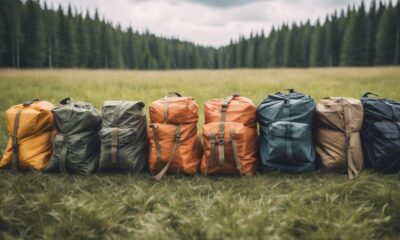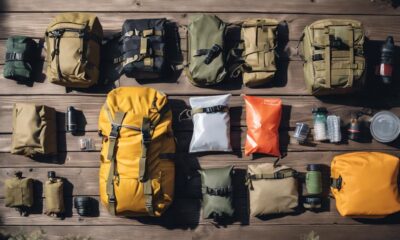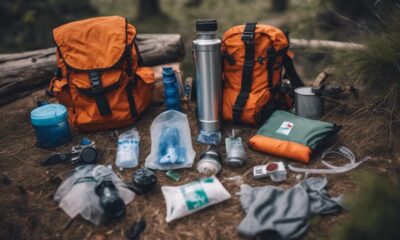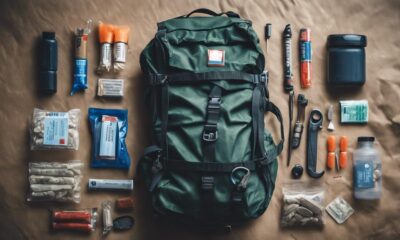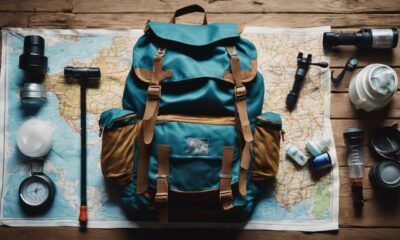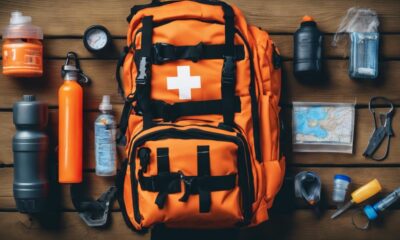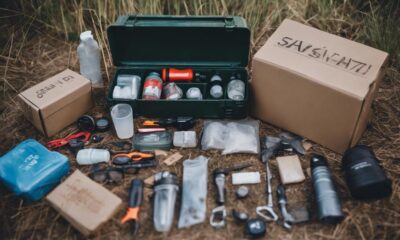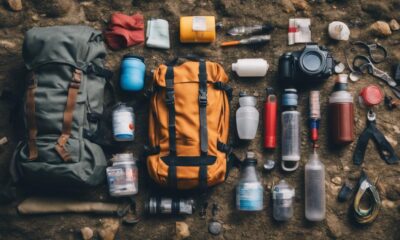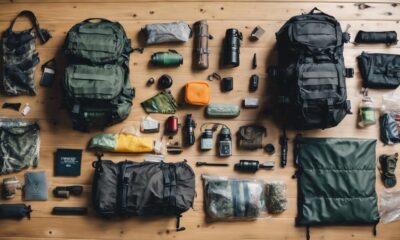Foraging Guides
Do Parakeets Need Foraging Toys? Find Out Why Here!
Ignite your parakeet's natural instincts with foraging toys, essential for their mental and physical well-being, but why are they so crucial?

As a parakeet owner, you're likely unaware that your bird has an innate need to forage, a behavior passed down through generations that's essential for their physical and mental well-being. Without foraging opportunities, your parakeet may develop behavioral issues, boredom, and stress. Foraging toys can prevent these problems by mimicking natural foraging behavior, providing mental stimulation, and encouraging physical activity. To keep your parakeet happy and healthy, you'll need to provide a variety of stimulating toys and activities. Learn how to choose the right toys and strategies to keep your feathered friend engaged and thriving – there's more to discover ahead.
Key Takeaways
- Parakeets need foraging toys to satisfy their innate foraging instinct, which is vital for their physical and mental well-being.
- Lack of foraging opportunities can lead to behavioral issues, stress, and boredom in parakeets.
- Foraging toys mimic natural foraging behavior, providing mental stimulation, physical activity, and problem-solving skills.
- A variety of foraging toys with different challenges, textures, and shapes can prevent boredom and keep parakeets engaged.
- Providing foraging toys is essential to promote a happy, healthy, and stress-free life for parakeets.
Foraging Instinct in Parakeets
When you bring a parakeet into your home, it's vital to recognize that you're not just caring for a pet, but also honoring the strong foraging instinct that has been hardwired into its DNA.
In the wild, parakeets' ancestors had to search for food to survive, and this natural behavior has been passed down through generations. As a result, your parakeet has an innate need to forage, which is necessary for its physical and mental well-being.
Foraging is an essential aspect of a parakeet's behavior, and it's crucial to provide opportunities for your pet to engage in this natural behavior. Without foraging opportunities, your parakeet may develop behavioral issues, such as feather plucking, due to boredom and lack of mental stimulation.
Benefits of Foraging Toys

By recognizing your parakeet's innate need to forage, you can take the next step in providing a fulfilling environment by incorporating foraging toys that cater to this natural behavior. These toys provide mental stimulation and prevent boredom in your parakeet, mimicking the natural foraging behavior they'd exhibit in the wild. This, in turn, encourages physical activity and problem-solving skills, keeping your feathered friend engaged and active.
Here are just a few benefits of incorporating foraging toys into your parakeet's environment:
- Prevents boredom and behavioral issues: By providing a challenge, foraging toys keep your parakeet's mind active, reducing the likelihood of boredom and associated behavioral problems.
- Encourages physical activity: Foraging toys require your parakeet to move around, climb, and manipulate objects, promoting exercise and physical activity.
- Mimics natural behavior: Foraging toys allow your parakeet to express its natural foraging instincts, providing a sense of fulfillment and satisfaction.
Choosing the Right Toys

When selecting the right foraging toys for your parakeet, you'll want to take into account a few key factors.
You'll need to contemplate how to keep your parakeet engaged and stimulated, and that means choosing toys that offer a mix of challenges and rewards.
Toy Rotation Strategies
You'll want to devise a toy rotation strategy that keeps your parakeet engaged and stimulated, as a stale toy selection can lead to boredom and behavioral problems. A well-planned rotation will guarantee your feathered friend stays curious and active.
Here are some key considerations for your toy rotation strategy:
- Rotate toys weekly to maintain bird interest and prevent boredom
- Introduce new textures, shapes, and challenges with each toy rotation
- Consider using a mix of foraging, shredding, and chewing toys for variety
Material Variety Matters
To guarantee your parakeet stays engaged and stimulated, it's important to select toys made from a variety of safe, stimulating materials that cater to their natural foraging instincts. You want to provide a diverse range of textures, shapes, and sensations to keep your parakeet's mind and beak active. Opt for toys made from natural wood, paper, and vegetable-based dyes to make sure your parakeet's safety. Avoid toys with small parts or breakable components that could pose a choking hazard.
Choose toys that offer foraging opportunities, such as puzzles or hidden compartments, to challenge your parakeet's problem-solving skills. A mix of shreddable, chewable, and interactive toys can help meet your parakeet's diverse enrichment needs.
Encouraging Natural Behavior

By providing foraging toys, you encourage your parakeet to engage in natural behaviors, such as searching for food, which are essential for its mental and physical well-being. As a bird, your parakeet has an innate instinct to forage for food, and denying it this opportunity can lead to boredom, stress, and destructive behaviors.
Here are a few ways that foraging toys can help your parakeet engage in natural behaviors:
- Mimicking natural foraging activities: Foraging toys can be filled with treats, encouraging your parakeet to search and dig, mimicking its natural foraging activities in the wild.
- Promoting physical activity: Foraging toys can be designed to require physical effort, such as lifting, pushing, or pulling, to access treats, keeping your parakeet active and engaged.
- Stimulating mental activity: Foraging toys can challenge your parakeet to problem-solve, stimulating its mental activity and reducing boredom and stress.
Preventing Boredom and Stress

Foraging toys are vital for preventing boredom and stress in your parakeet, as they provide a healthy outlet for its natural behaviors and instincts. Without these toys, your parakeet may develop behavioral issues like feather plucking due to lack of mental stimulation.
As a responsible pet owner, it's essential to provide your parakeet with engaging activities that mimic its natural behaviors in the wild. Foraging toys from reputable suppliers like Windy City Parrot offer a safe and entertaining way for your parakeet to explore, chew, and forage for treats.
By providing these toys, you'll enhance your parakeet's overall well-being and happiness. Imagine your parakeet happily digging and searching for treats, exercising its natural instincts without getting bored or stressed. Foraging toys make this possible, ensuring your feathered friend leads a happy and healthy life.
Enhancing Mental Stimulation

Providing your parakeet with a variety of foraging toys is essential for enhancing mental stimulation. It challenges them to think creatively and develop essential problem-solving skills. By introducing toys that mimic their natural foraging behaviors, you'll keep your parakeet engaged and stimulated.
This is especially important, as parakeets in the wild spend a significant amount of time foraging for food.
Some great options for foraging toys include:
- A woven vine filled with treats, encouraging your parakeet to dig and forage
- A puzzle toy that requires problem-solving skills to access the treats inside
- A foraging box filled with shredded paper and hidden treats, promoting exploration and discovery
Foraging for a Happy Bird

To keep your parakeet happy and fulfilled, you need to tap into their natural instinct to forage, which is essential for their mental and physical well-being. In the wild, birds spend a significant amount of time daily searching for food and staying alert to potential dangers. Without foraging opportunities, pet birds can become bored, develop picky eating habits, and exhibit behavioral issues.
As a responsible owner, you can provide your parakeet with a stimulating environment by introducing foraging toys. These toys offer entertainment, mental stimulation, and a rewarding activity for your pet bird.
Frequently Asked Questions
Do Birds Need Foraging Toys?
You're wondering if birds need foraging toys, and the answer is yes! Without them, birds can get bored, leading to behavioral issues. Foraging toys provide mental stimulation, physical exercise, and help prevent problems in captivity.
Do Parakeets Like to Forage?
You might be surprised to know that 80% of a parakeet's time in the wild is spent foraging! It's no wonder, then, that you'll find your parakeet will love to forage, as it's an innate behavior that keeps them engaged and stimulated.
What Toys Should Parakeets Avoid?
You should avoid giving your parakeet toys with small parts, toxic materials, sharp edges, long strings, or mirrors, as they can cause harm, injury, or stress; instead, opt for safe, stimulating toys that promote healthy exploration.
What Toys Do Parakeets Need?
As you venture into the world of parakeet parenting, you're probably wondering what toys your feathered friend can't live without. The answer is simple: foraging toys that challenge and engage, like puzzle feeders and shreddable wonders, to keep your parakeet's mind and beak busy!
Conclusion
As you provide foraging toys for your parakeet, you're not just keeping them entertained – you're unleashing their natural instincts. It's like giving them the keys to a treasure chest filled with mental and emotional riches.
By incorporating foraging toys into their environment, you're simulating the thrill of the hunt, exercising their problem-solving skills, and creating a happier, healthier bird. This not only helps alleviate boredom but also promotes natural behaviors, reducing the likelihood of stress-induced issues such as feather plucking or aggression. The benefits of foraging vs farming for food extend to mental stimulation, as foraging encourages birds to think critically and engage more actively with their surroundings, mimicking what they would experience in the wild. By gradually shifting their focus away from easy meals, you’re nurturing both their physical and mental well-being in the long run. Incorporating these activities is an excellent way to introduce variety into their daily routine, keeping them mentally sharp and physically active. Over time, the *foraging vs farming benefits* become evident, as birds develop better cognitive abilities and maintain a healthier weight due to the increased activity. Ultimately, these enrichment techniques enhance their overall quality of life, closely aligning with their natural instincts and behaviors in the wild.
So, get creative and watch your parakeet thrive in a world of foraging wonder!
Foraging Guides
National Park and Forest Foraging Rules
The rules for foraging in national parks and forests can vary greatly; discover what you need to know before your next adventure.
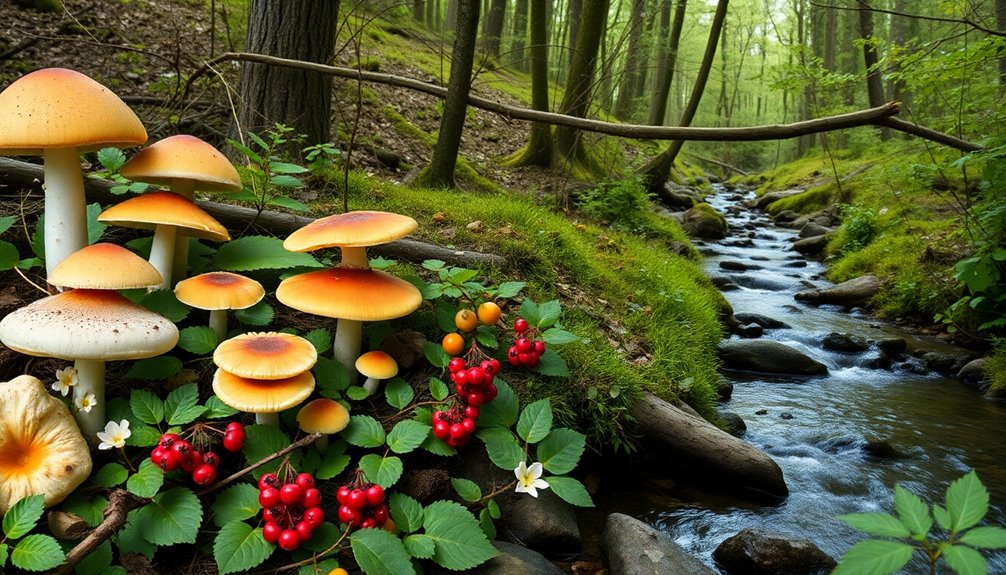
When you're out in national parks or forests, foraging can be a rewarding experience, but you need to be aware of the rules that govern it. Many parks allow limited personal foraging, yet each has its own set of regulations laid out in the Superintendent's Compendium. Understanding these guidelines is crucial to protecting the environment and ensuring your foraging remains lawful. What specific permits or limitations might you encounter in your local area? The answers could be pivotal for your next outdoor adventure.
Key Takeaways
- Foraging is generally prohibited in national parks unless specifically permitted by park superintendents; always check local regulations.
- Limited foraging for personal consumption is allowed in some parks, often with strict quantity limits.
- National Forests may require permits for foraging, and regulations can vary by state parks and local jurisdictions.
- Overharvesting is discouraged, and certain species may be protected or banned from collection entirely.
- Always confirm regulations with park managers or official resources to avoid penalties and support conservation efforts.
Introduction
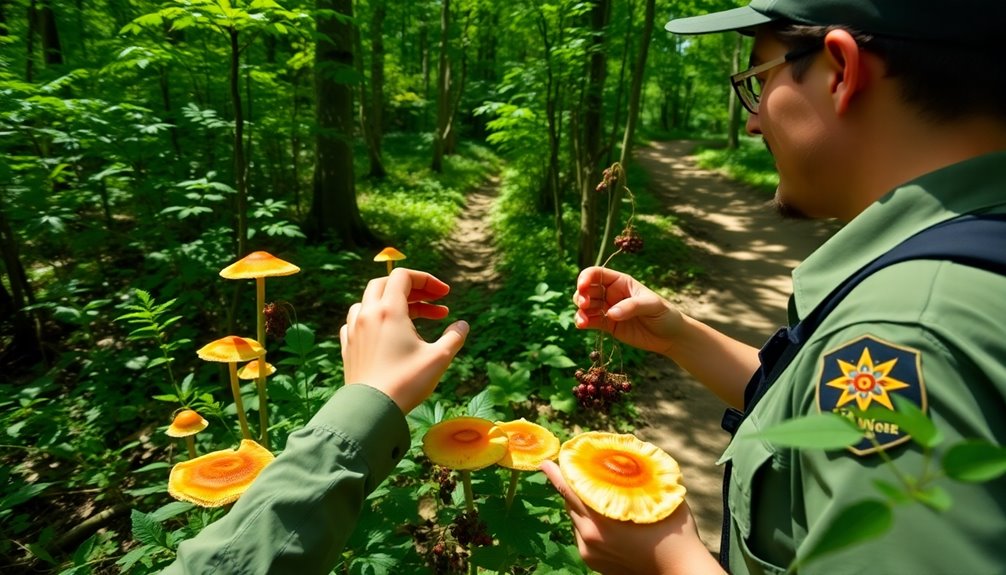
Foraging in national parks and forests offers a unique way to connect with nature, but it's crucial to understand the rules governing these activities. While many parks allow limited foraging, each has its own specific restrictions. Park superintendents have the authority to permit or prohibit foraging, setting rules that reflect the park's unique ecosystem and conservation goals.
You'll find that some parks encourage you to gather edible fruits, nuts, and mushrooms for personal consumption. For example, Grand Teton National Park allows foraging for a variety of berries and nuts, while Death Valley National Park features non-native fruits like grapes. Additionally, the National Park Service has recently modified policies to allow certain tribes to gather traditional plants under specific agreements. It's also important to note that foraging regulations can differ significantly across various types of public lands.
However, remember that commercial foraging is generally prohibited, except in certain National Forests.
Be mindful of quantity and location limits, as these rules help protect natural resources. In some parks, you might be restricted to gathering a quart of edible items per person per day or have specific areas designated for foraging.
Special considerations apply for federally recognized tribes, allowing them to gather plants for traditional purposes under strict agreements.
Legal Framework
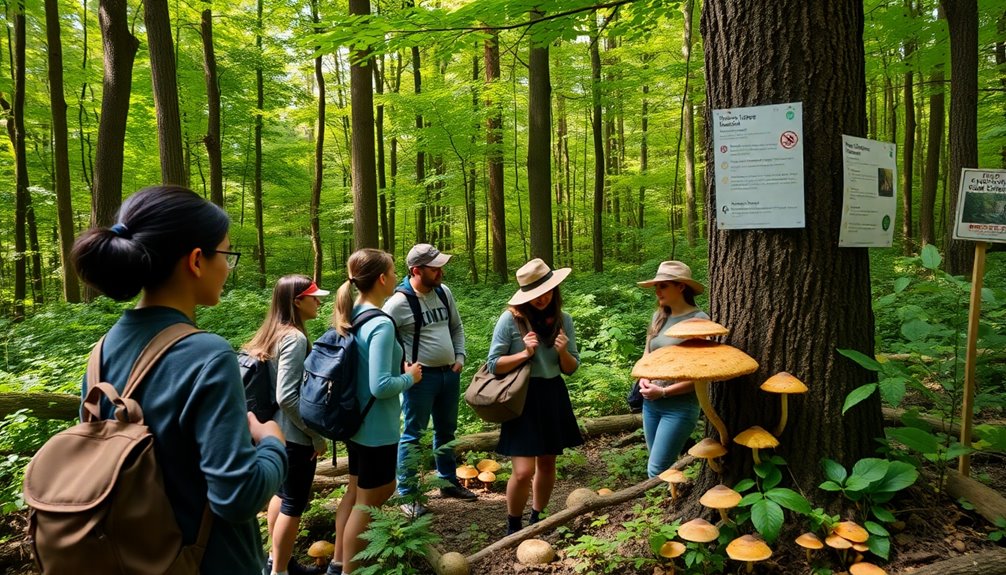
Navigating the legal framework for foraging in national parks and forests requires understanding the complex interplay of regulatory authorities and federal laws. The National Park Service (NPS) operates under the Department of the Interior, while national forests fall under the US Department of Agriculture (USDA). Each has distinct rules, and state parks have their own regulations, adding further complexity.
Federal laws, specifically 36 C.F.R. § 2.1, prohibit possessing or disturbing plants without permission, although park superintendents can grant exceptions. Foraging for commercial purposes is strictly forbidden. Tribal gathering rights allow members of federally recognized tribes to collect plants for traditional uses, but they must adhere to sustainability practices outlined in agreements with the NPS. Ultimately, the growing interest in foraging as a cultural practice underscores the importance of understanding these regulations.
In fact, approximately 75% of National Parks permit some form of foraging, reflecting a shift towards recognizing the practice's cultural significance. Enforcement varies, with park superintendents holding the power to restrict foraging types, methods, and quantities. Some parks ban all foraging, while others permit it under strict guidelines. Violating these rules can lead to fines and even jail time.
Always check specific regulations, as both federal and state rules can differ significantly. Understanding this legal framework is crucial for anyone looking to forage responsibly.
Main Guidelines
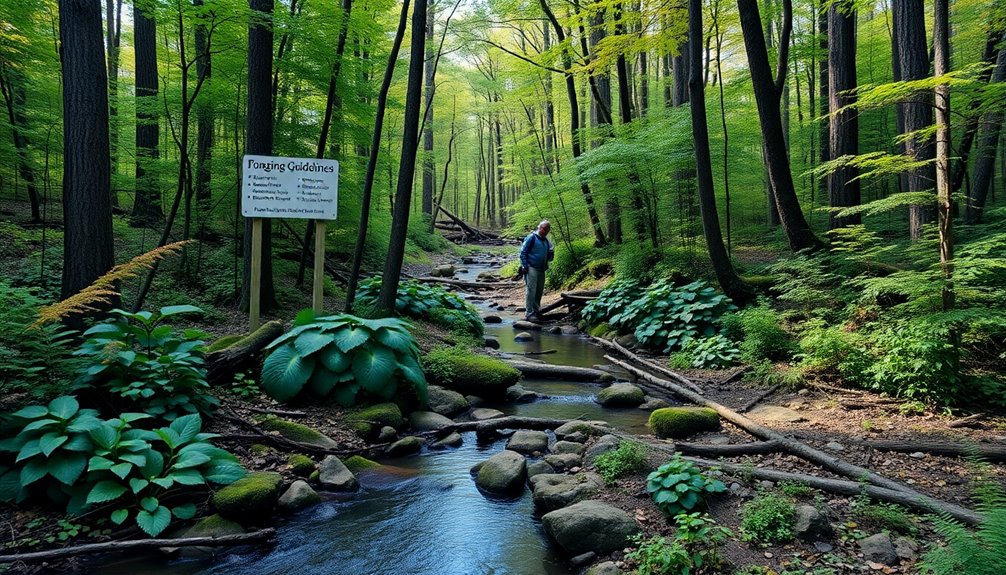
Understanding the main guidelines for foraging in national parks, forests, and other protected areas is essential for anyone interested in gathering wild foods.
In national parks, foraging is generally prohibited under 36 CFR § 2.1(c), though park superintendents can allow it with specific rules. If permitted, you might gather fruits, nuts, or particular wild foods, but expect restrictions on quantity and methods, such as a ban on using ladders. For example, in Shenandoah National Park, visitors can collect small amounts of certain wild fruits like blueberries and blackberries.
In national forests, you often need a permit, which you can obtain from Forest Service offices. Permits typically allow you to collect forest products like berries and mushrooms for personal use, but limits, like one gallon per day per species, may apply. It's important to note that obtaining collection permits is necessary for resource and collector protection.
Wildlife refuges generally prohibit foraging, although some may allow it for personal use, so check the specific rules for each refuge.
State parks, like those in Alabama, strictly prohibit foraging, including the collection of plants and mushrooms.
Always confirm any unclear rules with park managers to avoid penalties, which can include fines or jail time for violations.
Best Practices

When you're out in the wild, following best practices for foraging can make a big difference in preserving the environment and ensuring your activities are legal.
Start by understanding the specific regulations of the park you're visiting. Each national park has unique rules about what plants you can harvest, how to do it, and the allowed quantities. Always check the park's Superintendent's Compendium for detailed information, as more than half of U.S. national parks allow some form of foraging. It's important to remember that national parks promote conservation, which should guide your foraging decisions.
Respecting quantity limits is crucial. For example, in Death Valley National Park, you can collect up to one quart per person per day of certain edible plants. Adhering to these limits helps prevent overharvesting and protects park resources.
Ensure your foraging practices are sustainable. Hand gathering is usually required to avoid damaging plants and their ecosystems.
Steer clear of using ladders or machinery, as these methods can harm the environment.
Lastly, be aware of restricted areas where foraging isn't allowed, like formal gardens or camping spots.
Common Mistakes to Avoid
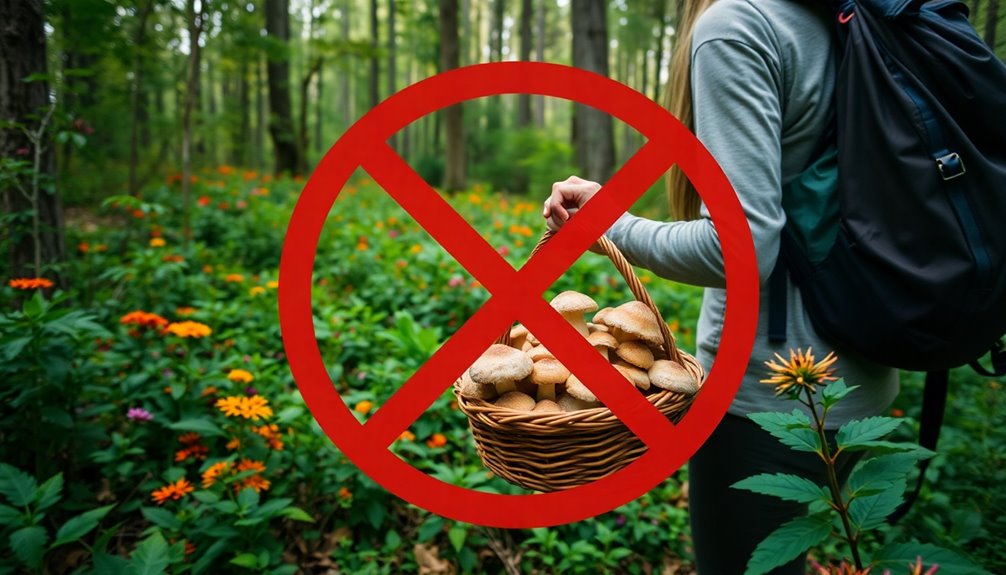
Foraging can be an enjoyable and rewarding experience, but there are common mistakes you need to avoid to ensure you're following the rules and protecting the environment.
First, always check the park's Superintendent's Compendium before you go. Regulations vary significantly between parks, and ignoring specific rules can lead to unintended violations.
Remember that exceeding quantity limits is another common error—most parks restrict how much you can collect, so track your intake to avoid fines.
Using prohibited methods is a big no-no. Stick to hand harvesting, as tools like ladders or machinery are often banned.
Additionally, you should respect restricted areas. Foraging in places like formal gardens or designated camping areas can harm sensitive ecosystems or lead to penalties.
Lastly, don't overlook seasonal restrictions. Some plants may only be harvested during specific times, and harvesting out of season can damage the ecosystem.
Special Considerations
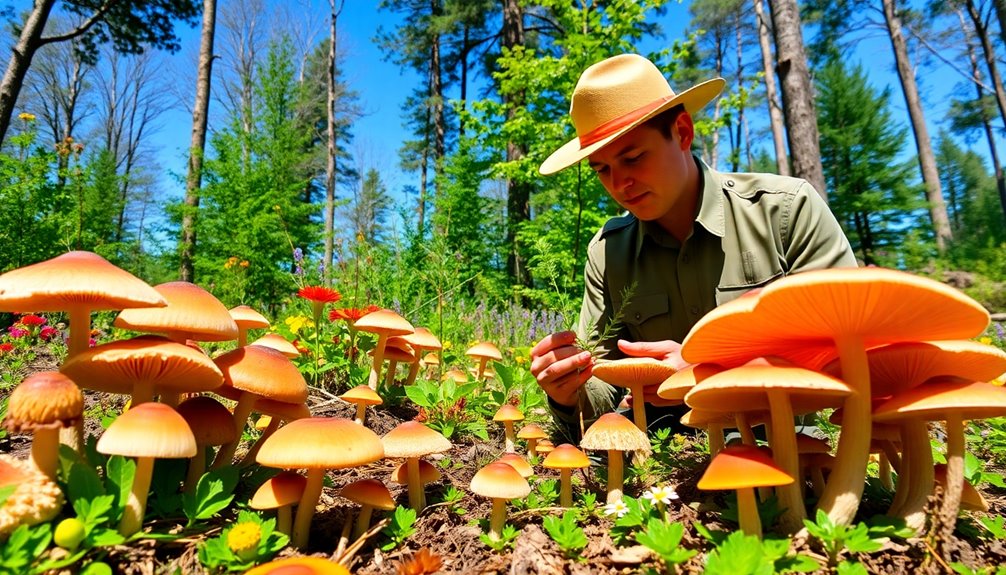
Special considerations play a crucial role in responsible foraging within national parks and forests.
You'll need to understand the unique rights and regulations that apply, especially concerning Indigenous and tribal foraging rights. Members of federally recognized tribes may have specific agreements that allow them to forage for traditional purposes, with guidelines on what plants, quantities, and methods are permitted.
Quantitative and methodological restrictions are common, like limits on how much you can collect—such as one quart per person per day for berries in Yellowstone National Park.
You'll often need to gather by hand and only for personal use, with some areas designated for foraging while others are off-limits.
Environmental and conservation considerations are also crucial. Park superintendents have the authority to restrict foraging to prevent overharvesting and might impose temporary bans to protect plant populations.
Certain species, like American Ginseng, are completely banned from harvest to aid conservation efforts.
Resources and References

Understanding the rules and resources related to foraging in national parks and forests is essential for anyone looking to explore this rewarding activity. Each park has its own regulations, often outlined in the Superintendent's Compendium. You should always check this document for specific rules regarding what you can forage and the allowed quantities.
For instance, while Death Valley National Park permits gathering mesquite beans and fruits of non-native plants, you can only collect less than one quart per person per day.
In contrast, Grand Teton National Park allows foraging of edible fruits and mushrooms with a limit of one quart per species per person per day.
Besides national parks, consider other public lands. National Forests require permits for foraging, while some state parks have their own rules that may differ significantly from national parks.
For accurate, up-to-date information, visit the official websites of the specific parks or the Forest Service.
Conclusion
In conclusion, foraging in national parks and forests can be a rewarding experience if you understand the rules and regulations. Always check the specific guidelines for the area you're visiting, respect quantity limits, and obtain any necessary permits. By following these practices, you'll help protect our natural ecosystems while enjoying the bounty they offer. Remember, staying informed and responsible ensures that future generations can enjoy foraging just like you do today. Happy foraging!
Foraging Guides
Protected Species Lists by Region
Learn how regional factors shape protected species lists and discover the hidden challenges that influence conservation efforts in your area. What might be missing?
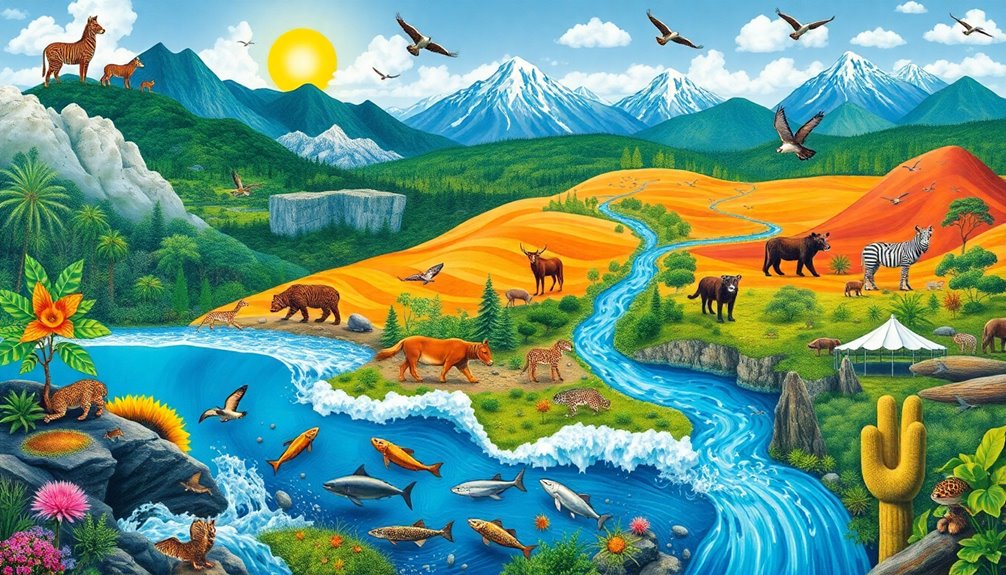
When you think about protected species lists, it's clear that these lists aren't one-size-fits-all; they're tailored to reflect the unique biodiversity and conservation needs of each region. You might wonder how these lists are developed and what factors influence their creation. Understanding the legal frameworks and guidelines that shape these lists can reveal much about local priorities and challenges. The implications extend beyond just names on a page, impacting conservation strategies and community involvement. But what specific regional factors come into play, and how do they affect the species that need protection?
Key Takeaways
- Protected species lists vary by region, reflecting local biodiversity and conservation needs, such as the IUCN Red List and national assessments.
- Regional Red Lists enhance collaboration, ensuring species status updates consider local ecological, cultural, and socio-economic factors.
- The Endangered Species Act (ESA) in the U.S. governs listing and protection processes for species, providing a legal framework for conservation.
- Accessing national Red List websites offers insights into species statuses across over 76 countries, aiding regional conservation efforts.
- Key examples of protected species include the Amur Leopard and Vaquita, highlighting critically endangered taxa in need of urgent conservation actions.
Introduction
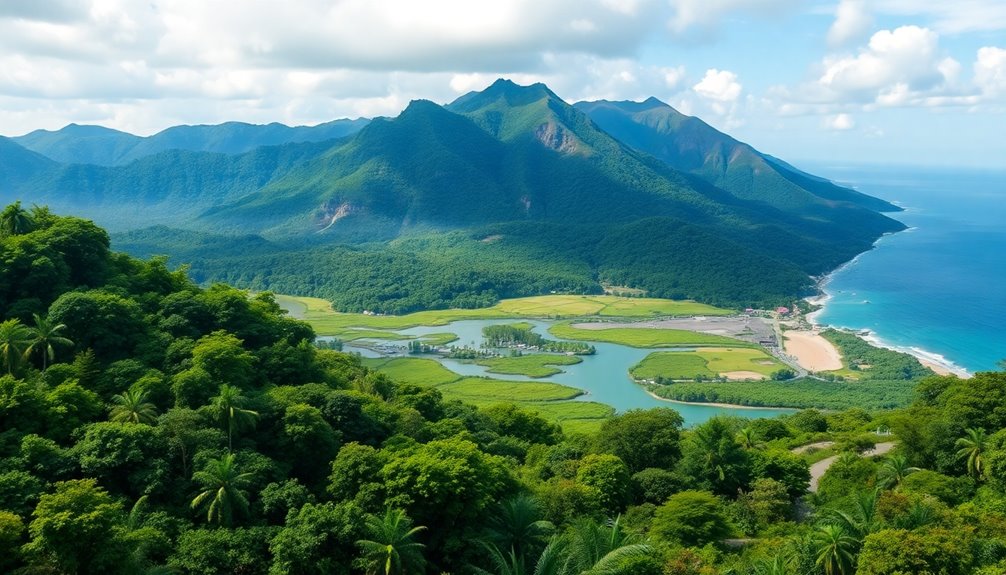
When it comes to protecting our planet's biodiversity, understanding the various species lists by region is crucial. These lists, including the IUCN Red List, help assess extinction risks and categorize species based on global populations. You'll find categories like Critically Endangered, Endangered, and Vulnerable, which cover a broad range of species, from mammals to fish. This global framework is essential for conservation efforts worldwide. Additionally, the NOAA Fisheries oversees a significant number of marine species under the ESA, highlighting the need for targeted conservation actions.
Regional assessments, or Regional Red Lists, adapt these categories for specific areas, helping countries report to international conventions like the Convention on Biological Diversity (CBD). These lists also facilitate information sharing between neighboring nations, enhancing collaborative conservation strategies.
On a national level, countries compile National Red Lists using IUCN guidelines, focusing on local biodiversity. With over 269,799 assessments from more than 76 regions, these lists play a vital role in shaping national conservation policies. Over 28,000 species are currently listed as threatened, emphasizing the urgent need for action.
Moreover, regional initiatives, like those coordinated by IUCN for Europe or the Mediterranean, target specific taxa, ensuring that conservation efforts are tailored to the unique needs of different ecosystems.
Understanding these lists is the first step toward effective biodiversity protection.
Legal Framework

The legal framework governing species protection is primarily shaped by the Endangered Species Act (ESA) in the United States. This act allows anyone, including you, to initiate a listing process for a species by submitting a petition. Federal agencies can also start this process on their own.
For your petition to be considered, it must include substantial biological data, leading to a 90-day finding to assess if further action is warranted. If warranted, a status review takes place within a year. The listing decisions are based solely on scientific and commercial data, ensuring that conservation efforts are grounded in factual information.
To be listed as endangered or threatened, a species must face imminent extinction risks or potential endangerment in the foreseeable future, based on the best scientific and commercial data available. Factors like habitat destruction and overutilization are critical in this assessment, while economic impacts aren't considered. Additionally, the ESA is complemented by laws such as the Marine Mammal Protection Act that provide preventive measures for specific marine species.
Once listed, the ESA triggers federal protections against adverse activities, including restrictions on taking or selling the species. Additionally, the law empowers authorities to develop recovery plans and purchase critical habitats.
Regular monitoring and cooperation with state agencies ensure that listed species receive the necessary protection to thrive or recover in their natural environments.
Main Guidelines

Regularly, guidelines for regional Red List assessments aim to ensure that species conservation efforts are consistent and effective across different areas. Developed by the IUCN, these guidelines help maintain comparability among regional and national Red Lists. They address critical issues like introduced taxa, marginally present taxa, and migratory species, ensuring a comprehensive understanding of biodiversity in each region. The criteria for assessment are based on the IUCN Red List Categories, focusing on regional extinction risk while considering global population contexts. You'll evaluate ecological, cultural, and socio-economic factors, as well as protection and management measures in place. Additionally, regional assessments support international treaties that aim to enhance species conservation efforts. Recent efforts have also emphasized the establishment of a national system for protected areas to improve species conservation practices.
The guidelines also introduce additional categories like Not Applicable (NA) and Regionally Extinct (RE).
Implementation involves promoting the sharing of species information between neighboring countries and facilitating national reporting to international conventions. Use a voluntary format for exemptions and reporting, and follow established procedures for nominating, listing, and delisting protected areas.
Best Practices

Implementing best practices in regional Red List assessments is crucial for effective conservation efforts. Start by using global standards, like the IUCN Red List Categories and Criteria, and adapt them for regional contexts. Make sure your assessments account for local factors, such as introduced or migratory species.
It's essential to employ standardized categories, including Not Applicable (NA) and Regionally Extinct (RE), to enhance clarity. Endangered species require urgent conservation measures that should be reflected in your assessments. Utilizing tools like IPaC can further streamline the process of identifying relevant species in your assessments.
Data sharing and collaboration are also key. Facilitate international cooperation by exchanging species information with neighboring countries. Utilize a national Red List website to provide easy access to assessments from over 76 countries and regions.
Ensure seamless communication between regional and global levels for better conservation strategies.
Don't forget to focus on regional specificity. Align your assessments with biodiversity targets from international conventions like the Convention on Biological Diversity (CBD).
Tailor your evaluations to local ecosystems, ensuring they inform national conservation policies effectively.
Common Mistakes to Avoid

Many regional assessments fall short due to common mistakes that can undermine conservation efforts. One major pitfall is using global criteria without tailoring them to local conditions. This can lead to misleading evaluations of species' statuses.
Moreover, neglecting the regional population dynamics and ignoring introduced, migratory, or marginal species can skew your understanding of biodiversity in your area.
Another mistake is failing to align your assessments with specific biodiversity targets and conservation policies relevant to your region. It's crucial to consider local Red Lists, as these play a significant role in international reporting.
Data incompatibility also arises when different classification systems are used, making regional comparisons difficult. Standardizing data collection methods can help avoid this issue.
Additionally, don't overlook local taxa. Non-endemic species or those present only during specific seasons may be at risk and deserve your attention.
Ensure you include all relevant species, like freshwater fishes or wetland plants, in your assessments. Lastly, keep your regional evaluations updated to reflect any changes in global species status, as this will enhance the effectiveness of your conservation strategies.
Special Considerations

When evaluating protected species lists, it's essential to consider various factors unique to your region. Start by recognizing that global criteria, like those from the IUCN Red List, may not always fit your local context. Adjustments are often necessary to avoid incorrect assessments, so utilizing coherent regional guidelines ensures comparability and accuracy.
Next, pay attention to the specifics of taxa in your area. Some species might only occur marginally or migrate during non-breeding seasons, which impacts their assessment.
Also, consider taxa that have become regionally extinct, as they remain relevant to conservation discussions.
Geographical and political boundaries also play a crucial role in your evaluations. Focus your assessments on these defined areas to aid in national reporting for international conventions like the CBD and SDGs.
This is especially important for marine species or freshwater taxa in specific regions.
Resources and References
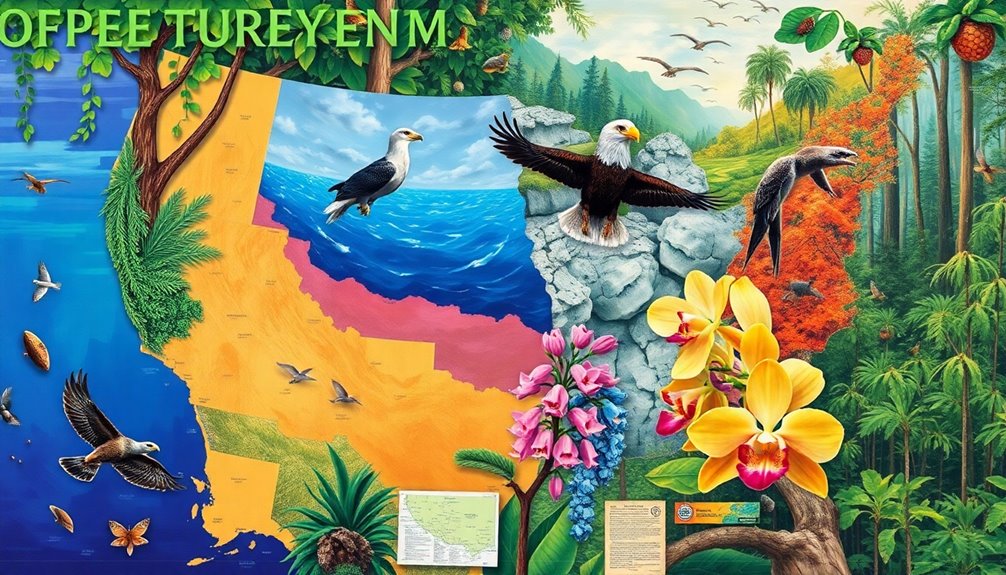
Understanding protected species lists requires access to reliable resources and references tailored to your region. For global insights, the WWF Species Directory and the IUCN Red List are essential. The IUCN provides crucial categories like Critically Endangered and Vulnerable, helping you understand the conservation status of various species worldwide, including the Amur Leopard and Vaquita.
If you're focusing on national or regional needs, the IUCN Regional Guidelines can help you apply these categories effectively. The National Red List website, hosted by the Zoological Society of London, offers assessments from over 76 countries, while specific regional initiatives cover areas like the Mediterranean and Gulf of Mexico.
For marine species, NOAA Fisheries provides a comprehensive directory that lists endangered marine life under the Endangered Species Act, including details on species like the Blue Whale and Atlantic Sturgeon.
If you're in the U.S., the U.S. Fish & Wildlife Service offers tools for searching local endangered species, along with guidelines on the listing process and habitat designations.
Utilizing these resources ensures you stay informed and engaged in conservation efforts.
Conclusion
In conclusion, understanding protected species lists is vital for effective conservation efforts. By familiarizing yourself with the legal frameworks, guidelines, and best practices specific to your region, you can actively contribute to preserving biodiversity. Remember to avoid common mistakes and consider the unique ecological and cultural contexts in your area. Utilize available resources to stay informed and engaged, ensuring that your efforts align with both local and international conservation goals. Together, we can make a difference!
Foraging Guides
Wild Edible Plant Identification Safety Tips
Harness the excitement of wild foraging with essential safety tips for identifying edible plants—discover what crucial information could save you from dangerous mistakes.
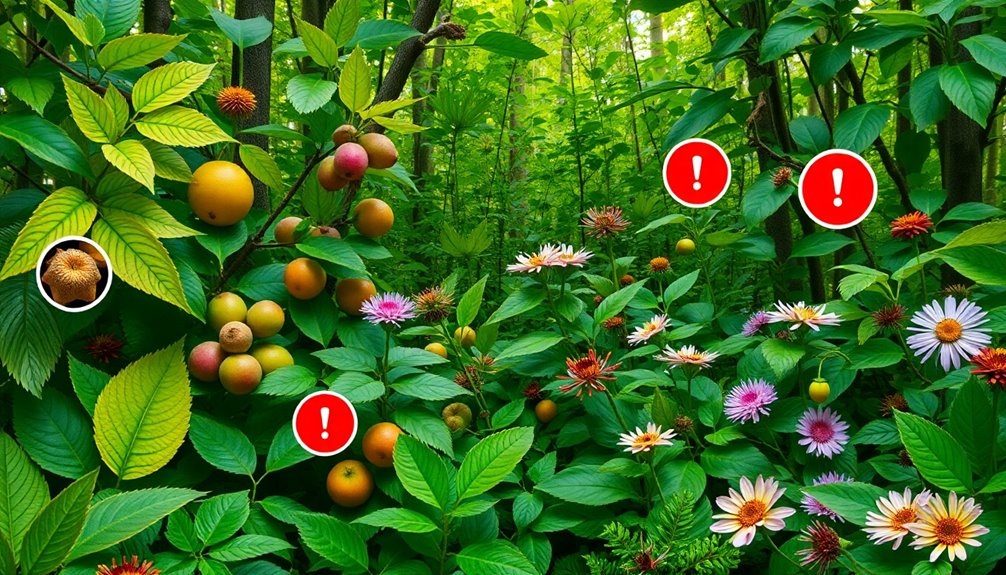
When you step into the world of wild foraging, understanding safety tips for identifying edible plants is crucial. You can't just rely on a single guide; using multiple resources and consulting seasoned foragers can help you avoid dangerous mistakes. Be mindful of poisonous lookalikes and the importance of odor in plant identification. While the thrill of foraging can be enticing, knowing how to approach it safely is essential. So, what are the specific guidelines and best practices that can ensure a positive experience in the wild?
Key Takeaways
- Always use multiple field guides for cross-referencing plant identification to ensure accuracy and avoid misidentification.
- Be aware of poisonous lookalikes and use the smell test to help identify potentially toxic plants.
- Perform the universal edibility test only on confidently identified plants and cook them to ensure safety.
- Check local laws and regulations regarding foraging, including any restrictions on state and privately managed lands.
- Join local foraging groups or workshops to gain hands-on experience and knowledge from seasoned foragers.
Introduction
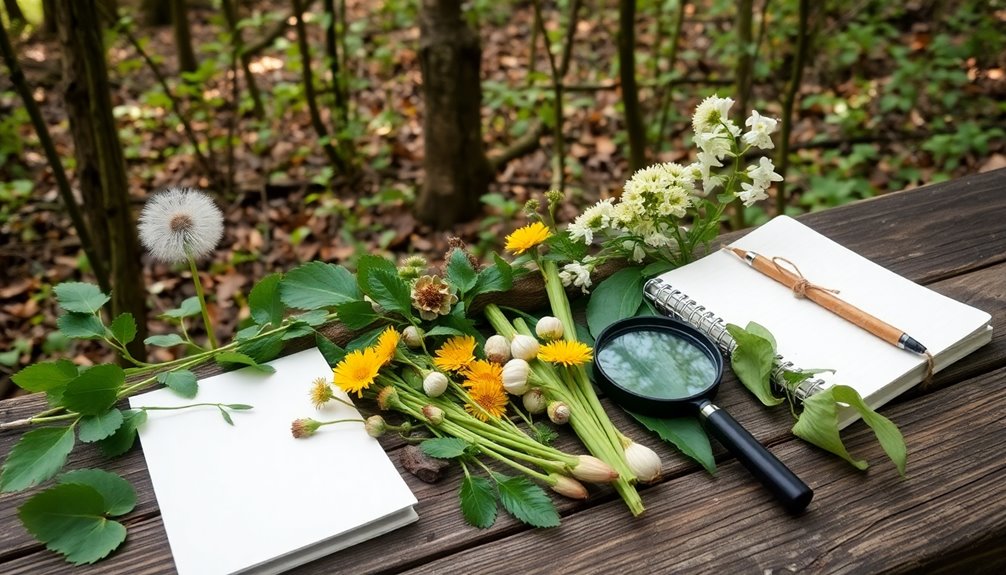
Foraging for wild edible plants can be an exciting and rewarding experience, but it's essential to approach it with care. Proper identification is your first line of defense against misidentification, which can lead to severe illness or even death. You need to know exactly what you're eating, rather than just what to avoid.
Familiarizing yourself with plant parts, growing seasons, and preferred habitats will help you make informed choices. Always use multiple field guides and resources for triple-confirmation of plant identity. In addition, engaging with community workshops can provide valuable hands-on experience and guidance from experts. Many wild edibles are available in North American forests, making foraging a diverse and sustainable food source.
Avoid common mistakes like eating a plant unless you're 100% sure of its identity. Just because animals eat it doesn't mean it's safe for you. Stay away from plants with strong odors or those growing in groups of three, which could indicate poison ivy. Don't force a plant to match a description; if it doesn't fit, leave it alone.
Learning botanical terms is crucial to grasp the details that matter.
Legal Framework
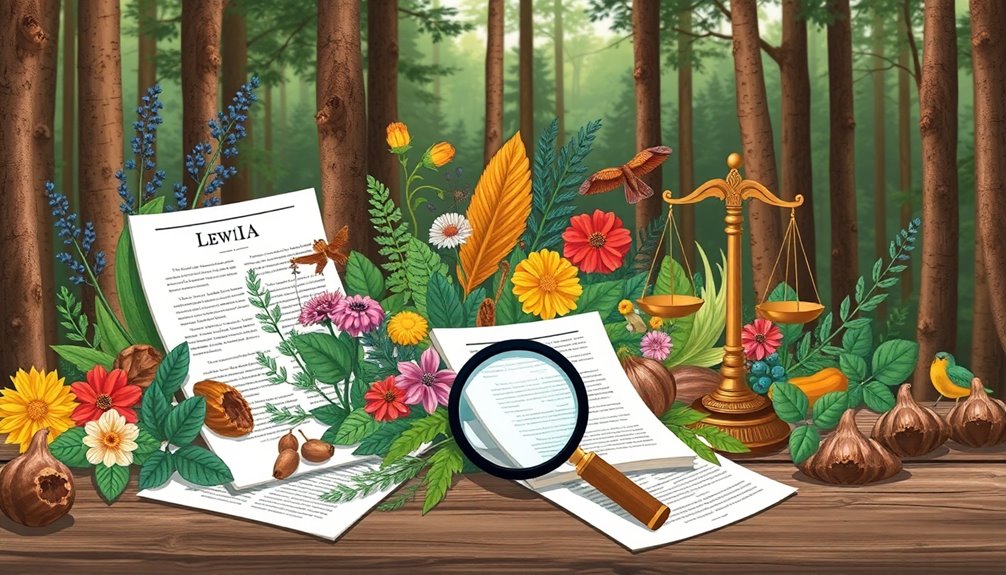
Understanding the legal framework surrounding wild edible plant foraging is vital for a safe and responsible experience. Before you head out, check the laws and regulations in your area. Different locations will have varying rules about where it's legal to gather wild plants and mushrooms.
Familiarize yourself with the regulations on state and federally managed lands, and make sure you obtain permission if you're foraging on private property. Always ensure the area is publicly accessible and not private without consent. Additionally, be aware that foraging baskets can be essential tools for carrying your harvest efficiently.
Look for signs or consult online resources provided by state parks or local authorities regarding foraging regulations. Avoid foraging near busy roads, city parks, or industrial areas to minimize exposure to pollutants. Opt for lightly traveled or untouched areas for clean and safe harvests. Additionally, focus on learning specific local edible species to enhance your foraging experience. Incorporating knowledge of ethical foraging principles will further enrich your understanding of sustainable practices.
It's crucial to respect land use and permissions. Always ask landowners and land managers before foraging, and be mindful of conservation areas where foraging might be prohibited.
Lastly, avoid trespassing by knowing property boundaries and respecting public right-of-way areas. Following these guidelines will help you enjoy foraging while ensuring you're acting within the law.
Main Guidelines
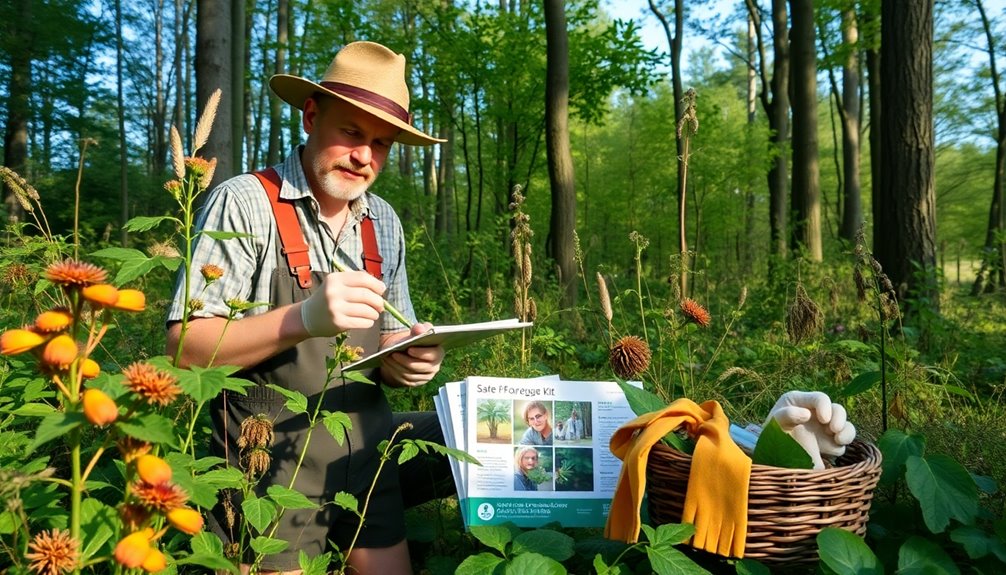
When you're out in the wild looking for edible plants, following some key guidelines can enhance both your safety and enjoyment.
Focus on leaf shape and arrangement, as well as reproductive parts like flowers and fruits, which are crucial for identification. Don't forget to observe the stalk and trunk for any distinctive traits. Engaging in outdoor activity while foraging can also enhance your observational skills and deepen your connection to the environment.
Be aware of poisonous lookalikes; for example, hemlock can mimic Italian parsley. Use your sense of smell to help identify plants; wild onions should smell distinctly onion-like.
If you're uncertain, perform the universal edibility test, but only consume plants you can confidently identify. Start with familiar plants, like blackberries and raspberries, to build your knowledge.
Lastly, remember that some plants require cooking to be safe, while others may have toxic parts. Always refer to regional guides to ensure you're making safe choices in the wild.
Best Practices
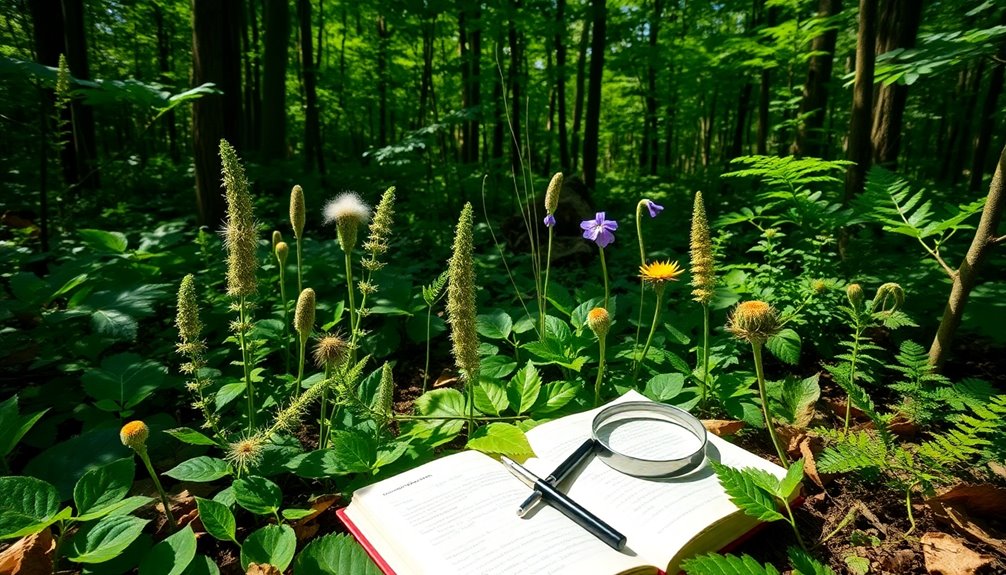
Building on the main guidelines for identifying edible plants, adopting best practices will enhance your foraging experience and ensure safety. Start by using multiple field guides like *Newcomb's Wildflower Guide* and *Peterson's Field Guide to Edible Wild Plants* for cross-referencing.
Observe plants throughout the seasons to recognize all phases of growth, and consider growing your own plants from seed to master their identification. Additionally, foraging wild plants can lead to higher nutritional content, benefiting your overall health. Foraging also promotes a connection with nature, which is essential for fostering a deeper appreciation of the environment.
Always obtain permission to forage in an area, and check for pollution signs to avoid contaminated plants. Remember to harvest only what you need, preserving the local ecosystem.
Be cautious about foraging from roadside ditches, as these areas may be treated with harmful chemicals.
Know which parts of each plant are edible and when they're safe to eat. Keep a journal to document your observations about edible parts and their seasonal availability.
If you're unsure about a plant's safety, employ the universal edibility test, starting with a smell test.
Common Mistakes to Avoid

Many common mistakes can undermine your foraging efforts and put your health at risk. One major error is misidentifying plants. Relying on just one field guide or a single characteristic can lead to dangerous mistakes, especially with look-alikes like hemlock and celery. Always consult multiple sources and learn the botanical terms to enhance your identification skills. Additionally, understanding tree relationships can significantly improve your foraging success, particularly when searching for mushroom species. It's also essential to recognize that some plants can resemble each other, leading to heat pump failures in identification. Moreover, familiarizing yourself with non-toxic houseplants can help you differentiate between safe and harmful species. Additionally, staying informed about personal debt forgiveness bills can help you manage the costs associated with foraging supplies.
Another mistake is ignoring environmental contaminants. Collecting plants near roads or industrial sites exposes you to pollutants, while plants growing in contaminated areas can harbor toxins. Always wash your finds thoroughly, especially those from damp or polluted locations. Additionally, always harvest only healthy specimens to avoid plants affected by pests or diseases. Avoid consuming plants with strong, unpleasant odors, as this can indicate potential toxicity.
Inadequate testing and preparation can also pose risks. If you're unsure about a plant's safety, perform the universal edibility test. Some plants need cooking to be safe, and it's crucial to avoid eating parts that aren't edible. Watch for allergic reactions like nausea or burning sensations. Staying updated on the latest foraging techniques can also improve your confidence and safety.
Lastly, don't forage without proper knowledge. Many plants can be harmful, and just because animals eat them doesn't mean they're safe for you. Always supervise children when foraging, and avoid unfamiliar areas without guidance. Caution is key to safe foraging.
Special Considerations

Special considerations are essential for successful and safe foraging. First, be mindful of the environment. Avoid areas near busy roads, railway lines, and industrial plants where heavy metals and pollutants may contaminate plants. Steer clear of locations treated with pesticides or herbicides, like field edges and farms. Remember that urban areas can also harbor contaminated wild edibles.
Next, familiarize yourself with the typical habitats and seasonal growth stages of the plants you're targeting. This knowledge helps prevent misidentification and ensures you recognize which parts are safe to eat at various times of the year. Always observe multiple specimens, as environmental conditions can alter their appearance.
It's crucial to be aware of poisonous lookalikes. Learn the distinctive characteristics of both edible and toxic plants, including their smell and texture. Use Latin names to avoid confusion with common names. Always cross-reference your findings using multiple field guides and consult experienced foragers when in doubt. Additionally, consider joining local foraging groups that offer workshops and resources to enhance your skills and knowledge about wild edibles in your area.
If unsure, take photos or samples for further research. By prioritizing these special considerations, you'll enhance your foraging safety and enjoyment.
Resources and References
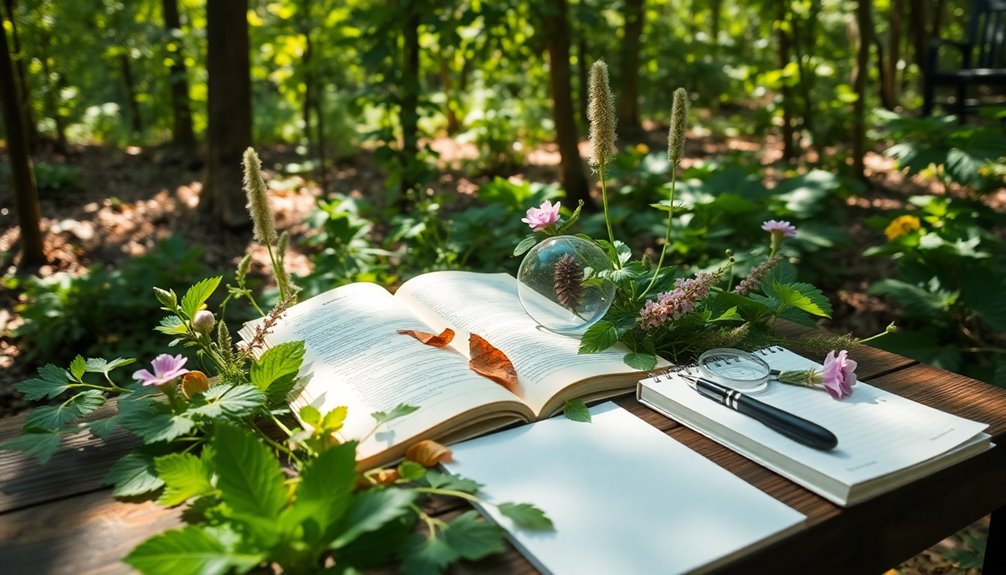
Consider seeking guidance from seasoned foragers or joining foraging clubs to gain hands-on experience.
Workshops and classes on wild edible identification can further enhance your skills.
Don't forget to utilize online databases and academic studies to stay updated on the latest research.
Lastly, while online plant identification tools and apps can be helpful, always cross-reference with physical guides to ensure you're making safe choices.
Conclusion
In conclusion, foraging for wild edible plants can be a rewarding adventure, but safety should always be your top priority. By following legal guidelines, properly identifying plants, and practicing sustainable harvesting, you can enjoy nature's bounty without the risks. Remember to consult multiple resources, avoid poisonous lookalikes, and be mindful of environmental conditions. With these tips in mind, you're well on your way to foraging confidently and responsibly. Happy foraging!
-

 Foraging Guides5 months ago
Foraging Guides5 months agoAre Forage Internships Worth It? Here's What You Need to Know!
-

 Vetted5 months ago
Vetted5 months ago15 Best Wilderness Survival Fiction Books to Fuel Your Adventurous Spirit
-
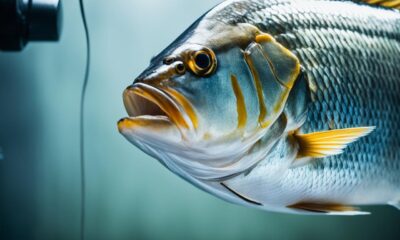
 Coastal Foraging5 months ago
Coastal Foraging5 months agoHow to Dry Age a Fish? The Ultimate Guide for Seafood Lovers
-
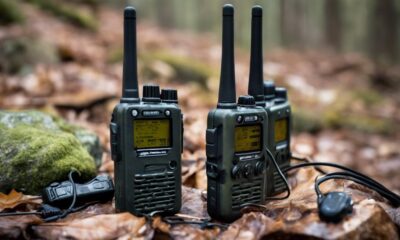
 Coastal Foraging5 months ago
Coastal Foraging5 months ago15 Best GMRS Radios for Preppers: Stay Prepared and Connected in Any Situation
-
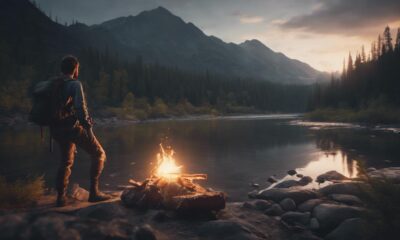
 Vetted5 months ago
Vetted5 months ago6 Best Wilderness Survival Games for Ios to Test Your Skills in the Wild
-
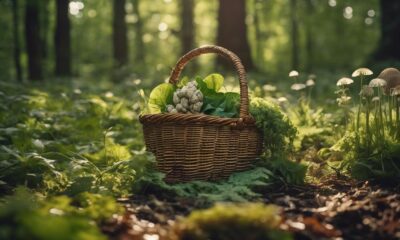
 How to Forage5 months ago
How to Forage5 months agoVirginia’s Wild Harvest: Forage for Delicious Edibles!
-

 Coastal Foraging5 months ago
Coastal Foraging5 months ago15 Best Baofeng Radios for Preppers – Stay Connected in Any Situation
-

 Survivalism5 months ago
Survivalism5 months agoPreppers Netflix: Top Shows to Watch for Survival Tips!




